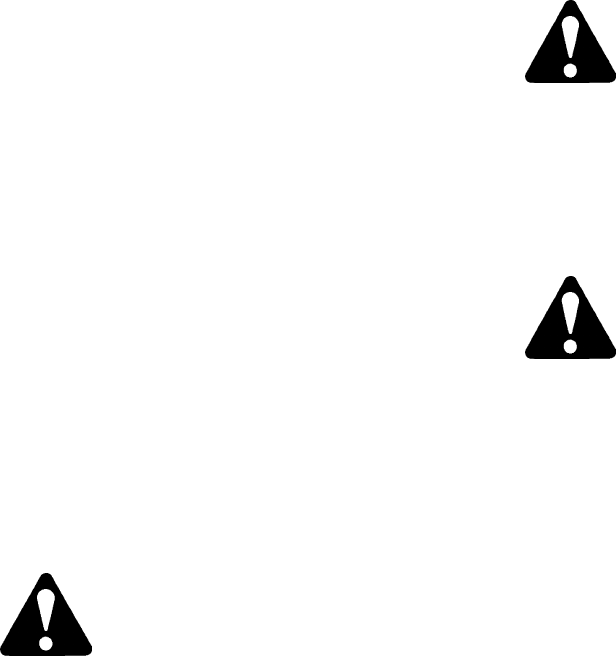
29
LUBRICATION AND MAINTENANCE
BATTERY
Keep the battery connections tight and free of
corrosion. An ammonia or baking soda-water
solution is good for washing the outside surface and
terminals of the battery. Make sure the solution does
not enter the battery. After cleaning, wash the
battery with clean water.
Apply a small amount of petroleum jelly to the
terminals to protect them from corrosion.
In freezing temperatures, the battery must be
maintained in a good state of charge. When a
battery is discharged or run down, the electrolyte is
weak and may freeze, causing damage to the case:
If it becomes necessary to add water (distilled), it
should be done just before using the tractor so the
charging will mix the water with the electrolyte and
prevent the water from freezing.
Determine the battery charge by checking the
specific gravity of the electrolyte.
Checking Electrolyte Level : Check the electrolyte
level in the battery every 50 hours.
WARNING: When the alternator is
charging, an explosive gas is
produced inside the battery. Therefore,
always check the electrolyte level with
the engine stopped. Do not use an
exposed flame and do not smoke when
checking the battery electrolyte level.
1. Clean the top of the battery, then remove the
vent plugs.
2. If the electrolyte level is low, add distilled
water. The level is correct when the liquid is
6.35mm above the plates.
NOTE : Keep distilled water in a clean, well-
covered, non-metallic container.
3. Install the vent plug after making sure the vent
holes are not blocked. At below freezing
temperatures, be sure to run the engine for a
period of time, after adding water, so the
battery will charge and prevent the water from
freezing.
NOTE : Reverse polarity will destroy the rectifier
diodes in the regulator.
CAUTION
l Never take the battery cap off while the
engine is running. Keep electrolyte
away from eyes, hands and clothes. If
you are spattered with it, wash it away
completely with water immediately.
l Gas given off by batteries is explosive.
To avoid injury or battery damage,
avoid sparks near the battery.
CAUTION
To avoid personal injury:
l When connecting the battery, do not
reverse the polarities. Connection with
reverse polarities will cause spark and
troubles to the battery and electrical
system in the tractor.
l When disconnecting the cable from the
battery, start with the negative terminal
first. When connecting, start with the
positive terminal first. Reversing the
steps may cause short-circuiting,
should a metallic tool touch the
terminals.
ALTERNATOR
The alternator, Figure 41, is belt-driven from the
engine crankshaft pulley. It is important that belt
slippage does not occur, otherwise, the charging
rate will be affected. Details of belt adjustment are
given on page 54.
Other than belt adjustment, the only maintenance
required on the alternator is to periodically inspect
the terminals and keep them clean and tight.
When working on or checking the alternator, comply
with the following precautions to prevent alternator
damage.
l DO NOT, under any circumstances, short the
FIELD terminal of the alternator to ground.
l DO NOT disconnect the voltage regulator
while the alternator is operating.
l DO NOT disconnect the alternator output lead
or battery cables while the alternator is
operating.
l DO NOT remove the alternator from the
tractor without first disconnecting the negative
(-) battery cable. If the battery is to be
removed, disconnect the negative cable first.


















